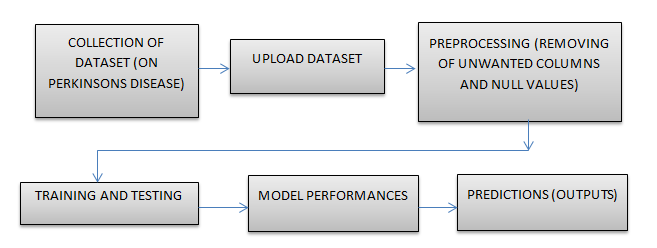A Comparative Study of Early Detection of Parkinson’s Disease using Machine Learning Techniques
Objective
In this application we are using Machine Learning algorithms for the detection of Parkinson's disease. Which can mainly detect four symptoms of the disease in the early stages namely, tremor at rest, bradykinesia, rigidity, and, voice impairment. And, the results of each algorithm are compared.
Abstract
Parkinson ’s disease (PD) is considered a malison for mankind for several decades. Its detection with the help of an automated system is a subject undergoing intense study. This entails a need for incorporating a machine learning model for the early detection of PD. For discovering a full proof model, the cardinal prerequisite is to study the existing computational intelligent techniques in the field of research used for PD detection. Many existing models focus on singular modality or have a cursory analysis of multiple modalities.
This encouraged us to provide a comparative literature study of four main modalities signifying major symptoms used for early detection of PD, namely, tremor at rest, bradykinesia, rigidity, and, voice impairment. State- of-the-art machine learning implementations namely Logistic Regression (LR), Support Vector Machine (SVM), Decision Tree (DT), K-nearest neighbors (KNN), Stochastic Gradient Descent (SGD) and Gaussian Naive Bayes (GNB) are executed in these modalities with their respective datasets. Furthermore, ensemble approaches such as Random Forest Classifier (RF), Adaptive Boosting (AB) and Hard Voting (HV) are implemented.
Keywords: Parkinson’s Disease, Machine Learning, Multimodal, Ensemble Approach and Bioinformatics.
NOTE: Without the concern of our team, please don't submit to the college. This Abstract varies based on student requirements.
Block Diagram

Specifications
SOFTWARE CONFIGURATIONS:
- Technology: Deep Learning, Python
- Libraries using: Pandas, Matplotlib, Numpy, Sklearn, Seaborn
- Version: Python 3.6+
- Server side scripts: HTML, CSS, JS
- Frame works: Flask
- IDE: Pycharm
HARDWARE CONFIGURATIONS:
- RAM: 4 or 8GB, 64 bit os.
- Processor: I3/Intel processor
- Operating system: Windows 7,8,9,10
Learning Outcomes
- Scope of Real Time Application Scenarios
- What is a search engine and how browser can work
- What type of technology versions are used
- Use of HTML , and CSS on UI Designs
- Data Parsing Front-End to Back-End
- Working Procedure
- Introduction to basic technologies used for.
- How project works.
- Input and Output modules.
- Frame work use.
- About python.
- About dataset.
- About machine learning algorithms.
- Project Development Skills:
- Problem analyzing skills.
- Problem solving skills.
- Creativity and imaginary skills.
- Programming skills.
- Deployment.
- Testing skills.
- Debugging skills.
- Project presentation skills.
- Thesis writing skills.





 Paper Publishing
Paper Publishing
